Omsa midterm 2 exam - Study guides, Class notes & Summaries
Looking for the best study guides, study notes and summaries about Omsa midterm 2 exam? On this page you'll find 22 study documents about Omsa midterm 2 exam.
Page 2 out of 22 results
Sort by
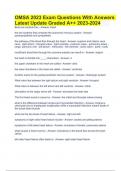
-
OMSA Exam Questions With Answers Latest Update | OMSA PRACTICE TEST Questions With Answers Latest Update 2023-2024 | OMSA Midterm 2 Exam With Complete Solutions Latest Updated Graded 2023/2024 | Omsa Exam Questions And Answers Latest Update AND OMSA Study
- Package deal • 5 items • 2023
-
- $32.49
- + learn more
OMSA Exam Questions With Answers Latest Update | OMSA PRACTICE TEST Questions With Answers Latest Update 2023-2024 | OMSA Midterm 2 Exam With Complete Solutions Latest Updated Graded 2023/2024 | Omsa Exam Questions And Answers Latest Update AND OMSA Study Guide With Complete Solutions Latest Graded A+ 2023-2024 (GRADED 100%)
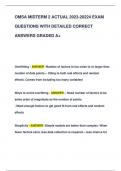
-
OMSA MIDTERM 2 ACTUAL 2023-20224 EXAM QUESTIONS WITH DETAILED CORRECT ANSWERS GRADED A+
- Exam (elaborations) • 21 pages • 2024
-
- $19.49
- + learn more
OMSA MIDTERM 2 ACTUAL EXAM QUESTIONS WITH DETAILED CORRECT ANSWERS GRADED A+ OMSA MIDTERM 2 ACTUAL EXAM QUESTIONS WITH DETAILED CORRECT ANSWERS GRADED A+ OMSA MIDTERM 2 ACTUAL EXAM QUESTIONS WITH DETAILED CORRECT ANSWERS GRADED A+ OMSA MIDTERM 2 ACTUAL EXAM QUESTIONS WITH DETAILED CORRECT ANSWERS GRADED A+ OMSA MIDTERM 2 ACTUAL EXAM QUESTIONS WITH DETAILED CORRECT ANSWERS GRADED A+ OMSA MIDTERM 2 ACTUAL EXAM QUESTIONS WITH DETAILED CORRECT A...
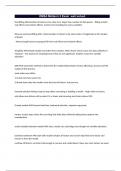
-
SA STUDY BUNDLE PACK SOLUTION 2024 (Questions and Answers )(Verified Answers)
- Package deal • 6 items • 2024
-
- $21.49
- + learn more
OMSA Midterm 2 Exam well solved/OMSA FALL PRACTICE TEST 2024 Questions and Answers (Verified Answers)/OMSA Recertification Practice Test 2024 Questions and Answers (Verified Answers)
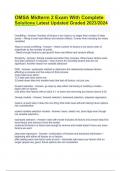
-
OMSA Exam Practice Questions and Answers Latest Updated 2023/2024
- Exam (elaborations) • 9 pages • 2023
- Available in package deal
-
- $14.99
- + learn more
OMSA Midterm 2 Exam With Complete Solutions Latest Updated Graded 2023/2024. Ways to avoid overfitting - Answer- - Need number of factors to be same order of magnitude as the number of points - Need enough factors to get good fit from real effects and random effects Simplicity - Answer- Simple models are better than complex. When fewer factors exist, less data collection is required -- less chance for including factors that are not significant. Another reason for variable selection! DOE - ...
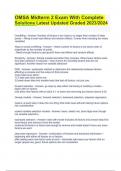
-
OMSA Midterm Exam Questions With Complete Solutions Latest Updated 2023/2024
- Exam (elaborations) • 9 pages • 2023
- Available in package deal
-
- $12.49
- + learn more
OMSA Midterm Exam Questions With Complete Solutions Latest Updated 2023/2024. DOE - Answer- systematic method to determine the relationship between factors affecting a process and the output of that process. must make sure either: 1) 2 data sets have same mix 2) break down data into smaller tests that test all factors, not just one. forward selection - Answer- go step by step either narrowing or building a model -- begin with no factors. only allow new factors with p-value 0.1 or lower an...
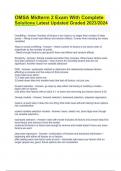
-
OMSA Midterm Exam Questions With Complete Solutions Latest Updated 2024 (Graded )
- Exam (elaborations) • 9 pages • 2024
-
- $12.49
- + learn more
OMSA Midterm Exam Questions With Complete Solutions Latest Updated 2024 (Graded ) Overfitting - Answer- Number of factors is too close to or larger than number of data points -- fitting to both real effects and random effects. Comes from including too many variables! Ways to avoid overfitting - Answer- - Need number of factors to be same order of magnitude as the number of points - Need enough factors to get good fit from real effects and random effects Simplicity - Answer- Simple models a...
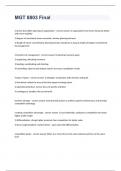
-
OSMA solution pack 2023 verified to pass
- Package deal • 18 items • 2023
-
- $44.99
- + learn more
1 Exam (elaborations) Dell EMC PowerEdge Specialist DES-4121 Exam Questions - Killtest fully solved 2023 2 Exam (elaborations) MGT 6311 gatech Midterm question well answered graded A+ 2023 3 Exam (elaborations) MGT 8803 Final question well answered 2023 verified to pass 4 Exam (elaborations) MGT 8803 GTx OMSA Financial Accounting - Basic Underst
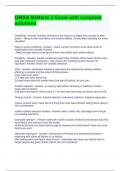
-
OMSA Midterm 2 Exam with complete solutions
- Exam (elaborations) • 9 pages • 2023
- Available in package deal
-
- $10.49
- + learn more
Overfitting - Answer- Number of factors is too close to or larger than number of data points -- fitting to both real effects and random effects. Comes from including too many variables! Ways to avoid overfitting - Answer- - Need number of factors to be same order of magnitude as the number of points - Need enough factors to get good fit from real effects and random effects Simplicity - Answer- Simple models are better than complex. When fewer factors exist, less data collection is require...
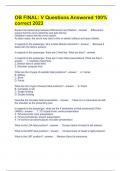
-
OMSA TEST EXAM COMPILATION BUNDLE
- Package deal • 13 items • 2023
-
- $51.99
- + learn more
Exam (elaborations) NURS 113 - CH13 - LABOR & BIRTH PROCESS Questions and Answers 2023 Exam (elaborations) OB FINAL: V Questions Answered 100% correct 2023 Exam (elaborations) ISYE 6501 - Midterm 1 Questions and Answers 2023 Exam (elaborations) omsa pharmacology Questions and Answers 2023 Exam (elaborations) OMSA Exam #2 Questions and Answ
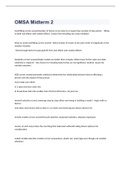
-
OMSA Midterm 2 exam 2023 with 100% correct answers
- Exam (elaborations) • 12 pages • 2023
-
- $14.49
- + learn more
Overfitting Number of factors is too close to or larger than number of data points -- fitting to both real effects and random effects. Comes from including too many variables! Ways to avoid overfitting - Need number of factors to be same order of magnitude as the number of points - Need enough factors to get good fit from real effects and random effects Simplicity Simple models are better than complex. When fewer factors exist, less data collection is required -- less chance fo...

How much did you already spend on Stuvia? Imagine there are plenty more of you out there paying for study notes, but this time YOU are the seller. Ka-ching! Discover all about earning on Stuvia


